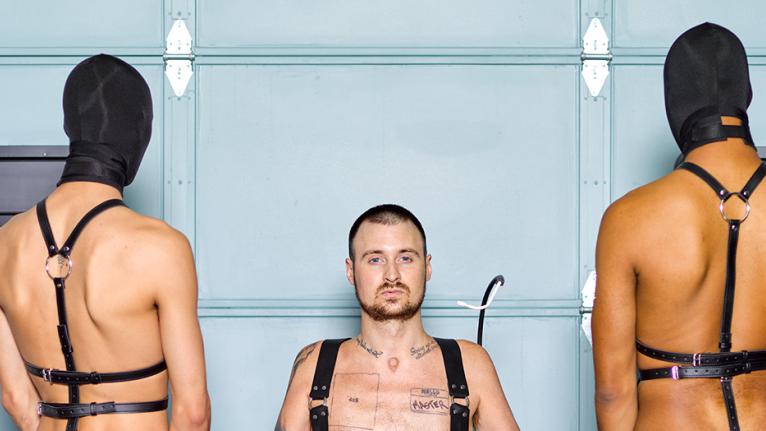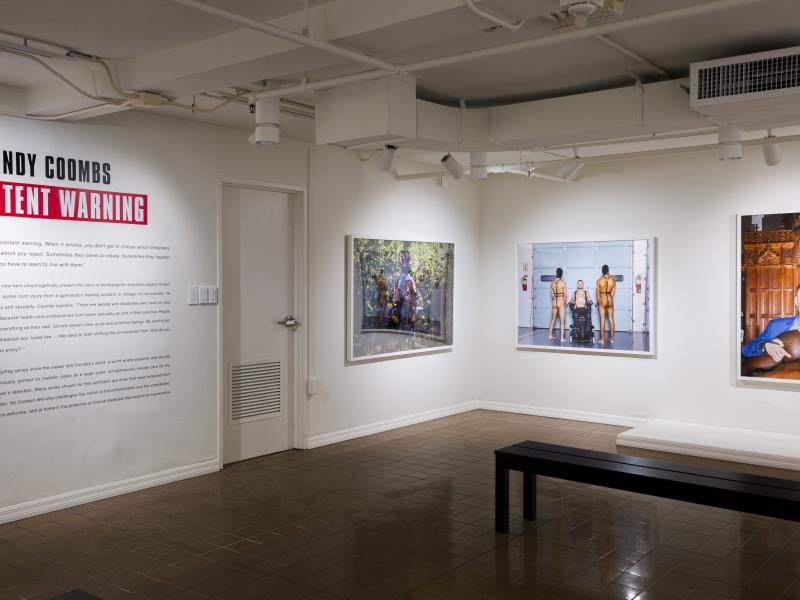ONE Archives at the USC Libraries presents a solo show of works by contemporary queer and disabled photographer, Robert Andy Coombs. The nine erotic and sultry photographs on view unapologetically present the vision of artist and often subject, Robert Andy Coombs. For some of the works, this will be the first time that they have been publicly exhibited.
Coombs grew up in Michigan's majestic Upper Peninsula where he started photographing his walkabouts in the woods in middle school. He moved on to portraiture in high school and earned a scholarship to Kendall College of Art and Design in Grand Rapids for undergrad. During his third year, Coombs sustained a spinal cord injury due to a gymnastics training accident, but he returned to KCAD and received his BFA in photography in 2013. Coombs's photography explores the intersections of disability and sexuality. Themes of relationships, caregiving, fetish, and sex are depicted and explored throughout. Coombs graduated from the Yale School of Art with his MFA in photography amidst the COVID-19 pandemic.
All the works on view are drawn from Coombs’s CripFag series, which has earned him praise from major voices in the art world, including Jerry Saltz who lauded: “His is among the most unshakable new work, by a new voice, I have come across in years. At the end of 2019, I included Coombs on a top-ten list of the year’s best; in the month since, I haven’t been able to get his work out of my head.” Despite this praise, Coombs has faced censorship by social media and the art world alike. Coombs watched this happen, and, in a 2024 social media post, he wrote: “I get it, I am not digestible to the general public and neither is my artwork.” Refusing to acquiesce to the general public even if he could, Coombs further wrote: “I didn’t get to choose any aspect of my disability, whereas society picks and chooses how, what, when, and who they want to interact with when it comes to disability. Wake up six, that’s not how life works.”
These nine works, selected from his CripFag series, invite the viewer into Coombs’s world: a world where disability and sex are not at odds. The photographs, luxuriously printed on metallic paper at a large scale, simultaneously convey compassion for the subjects while they demand the viewer’s attention. Many works chosen for this exhibition were censored from other institutions. Robert Andy Coombs: No Content Warning challenges prejudices about what is unmarketable or unpalatable. Here at ONE Archives, in the presence of diverse materials that explore all expressions of queer sexuality, these works are welcome and at home.
Please join us on Friday June 14 for an opening reception and program for Robert Andy Coombs: No Content Warning. Doors will open at 6 and remarks will begin at 6:30. ONE Archives Curator Alexis Bard Johnson will introduce the exhibition and art historian Cyle Metzger. Dr Metzger will present a visual history of disability in the U.S., identifying some of the social issues in Coombs’s work that have plagued disabled people since the 19th Century. He will chart a path through American art that will show how little has changed in the history of disability in the U.S., despite landmark legislation such as the Americans with Disabilities Act. His presentation will also demonstrate how important visual art has been to telling the stories of disabled people and how truncated those stories have been because they have come from non-disabled perspectives. Dr. Metzger’s presentation will be followed by a conversation between artist and scholar before taking questions from the audience. A small reception will follow with time to view the exhibition.
Biographies
Robert Andy Coombs grew up in Michigan's majestic Upper Peninsula where he spent his childhood roaming the great outdoors. He started photographing his walkabouts in middle school and moved on to portraiture in high school. Coombs received a scholarship to Kendall College of Art and Design in Grand Rapids Michigan. During his third year in undergrad, Coombs sustained a spinal cord injury due to a gymnastics training accident. After a year of recovery, he returned to KCAD and received his BFA in photography in 2013. Coombs' photography explores the intersections of disability and sexuality. Themes of relationships, caregiving, fetish, and sex are depicted and explored throughout. Coombs graduated from the Yale School of Art with his MFA amidst the COVID-19 pandemic and is currently residing in coastal Alabama.
Cyle Metzger is Assistant Professor of Art History at Bradley University in Peoria, Illinois and Co-Executive Editor of Panorama, the Journal of the Association of Historians of American Art. His scholarship focuses on transgender and disability history in American art and culture. His first book, Deep Cuts: Transgender History in American Art after World War II, engages histories of gender transformation in American art since the end of the Second World War. He has two articles on artist Greer Lankton forthcoming in journals American Art and Feminist Studies. In 2021, he co-edited an issue of the Journal of Visual Culture titled “New Work in Transgender Art and Visual Culture Studies.” Dr. Metzger has also written articles on artists Chris E. Vargas’s Museum of Transgender Hirstory and Art for Transgender Studies Quarterly and on artist Forrest Bess for the Archives of American Art Journal.
Alexis Bard Johnson is the Curator at the ONE Archives at the USC Libraries. She oversees the exhibitions, programs, and art collection at one of the largest repositories of lesbian, gay, bisexual, transgender, and queer materials in the world. Johnson earned her PhD in Art History with a minor in Feminist, Gender, and Sexuality Studies from Stanford University. Before joining the ONE Archives, Johnson worked at the Princeton Art Museum, the Whitney Museum, and the Terra Foundation for American Art. She most recently curated Looking for Lesbians and Archival Intimacies: Queering South/East Asian Diasporas. She is currently working on Sci-fi, Magick, Queer L.A.: Sexual Science and the Imagi-Nation, one of the exhibitions in the Getty’s 2024 Pacific Standard Time.

